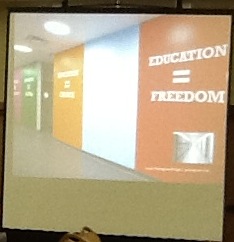In two presentations at TCEA’s Tecsig conference, David Jakes thoughtfully approached how we make our spaces reflect what we know about learning and teaching. Whenever we approach a learning space, shouldn’t we approach it with intent and thoughtfulness? Yet how often do we actually do that? Or how often do we revert to known formulas, room configurations and furnishings?
“The first step in rethinking the classroom is to disregard the notion that it has to be a classroom.” – D. Jakes
What leads us to believe that a classroom has to have four walls, rows of desks, (or desks at all), be square and not circular, be centered around the teacher? (Or why a library has to have a front desk the size of a small ship?)
“If we follow the Five C’s–Communication, Collaboration, Critical Thinking, Creativity, and Citzenship, then does our building and learning space reflect that?” – D. Jakes
David pointed out that to make these sorts of changes, you need to have professional growth centered around how to redesign spaces, and how to teach in spaces that are reflective of the school’s philosophy. When we(or architects) redesign the notion of a library or a classroom, do teachers or librarians change their strategies to match the space? I often wonder about this. Also, I wonder, why shouldn’t teachers be involved in the redesign of classrooms? Why aren’t librarians more often included in redesign of library spaces? What if the teachers or librarians are resistant to the design changes that are brought in from outside? How does redesign both reflect the climate and goals of the school, but also move the conversation forward? Should it do that?
Jakes shared a number of resources to help schools rethink design, including the books The Third Teacher, the Stanford design school book, Make Space, and Educause’s title, Learning Spaces. He drew attention to the design thinking process, which we can use to question and rethink our ideas about design. It starts with understanding the people using the space, then helps us “ideate” possibilities, then helps participants to prototype their ideas and test them out. Having been through this process, it’s so key to really asking and listening to the users of a space(like a library). What do they have to say about how they might use the library, how they read, learn, work? In classrooms, how do our students think, practice, talk, listen? If they were learning independently, what would their habits be? Listening and gaining understanding is critcal to the design thinking process. I found it the most fascinating part of going through a design thinking workshop and in the example Jakes shared (an IDEO design contest to redesign the shopping cart), you could see how the listening process helped inform the design process.

Jakes pointed how all the spaces in a building can be used for learning; hallways, nooks, etc. Why do we waste that valuable real estate? Desks in libraries (like our front desk) can double as poetry magnet boards, hallways can double as places where you convey the messages of the school’s priorities.
As David quoted Will Richardson, “Every classroom should be a space where people have possibilities every day.” Isn’t part of what contributes to that sense of possibilities the way the space provides those opportunities?
Intent behind the design–it doesn’t take money, but only creativity, mindfulness, and care.
For a very helpful set of resources from David Jakes’ work on design, check out his digital space at jakes.editme.com.
One thought on “What’s your intent? Design, intention and planning”